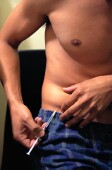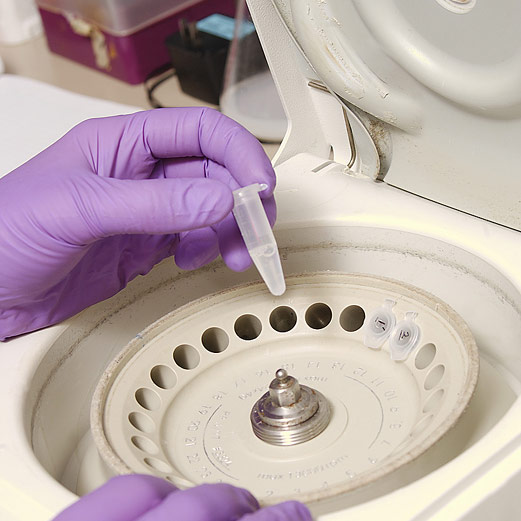
THURSDAY, Feb. 6, 2014 (HealthDay News) — In a potential breakthrough for the treatment of type 1 diabetes, researchers have successfully turned mouse skin cells into insulin-producing beta cells.
And when those cells were transplanted into a few dozen diabetic mice, their blood sugar levels returned almost to normal, the scientists found.
What’s more, they noted, the technique used to transform these cells is safer than other methods that have been used to transform one type of cell into another.
If this treatment works in humans as it does in mice — which remains a big hurdle — it could mean the end of daily insulin injections for people with type 1 diabetes, the researchers suggested.
“If we can produce unlimited beta cells, it would represent a potential cure for type 1 diabetes,” said the study’s senior author, Dr. Sheng Ding, a senior investigator at Gladstone Institutes, and a professor of pharmaceutical chemistry at the University of California, San Francisco.
Type 1 diabetes is an autoimmune disease, according to JDRF (formerly the Juvenile Diabetes Research Foundation). That means the body’s immune system attacks healthy cells instead of foreign cells, such as bacteria.
In the case of type 1 diabetes, the immune system destroys the insulin-producing beta cells in the pancreas. Insulin is a hormone that’s necessary to properly metabolize the carbohydrates in food to provide energy for the body and brain.
People with type 1 diabetes make little or no insulin. To survive, they must take multiple daily insulin shots or use an insulin pump that delivers insulin via a small tube inserted under the skin every few days.
Ding said that replacing beta cells through transplantation has been successful, but there are drawbacks. People receiving transplants must take immune-suppressing medications, which have side effects and long-term risks. Additionally, there simply aren’t enough donors to match the potential demand. And, the immune system in type 1 diabetes remains ever ready to destroy new insulin-producing cells.
So, what’s needed is a large supply of beta cells for transplant. That’s where the idea of turning plentiful cells, such as skin cells, into beta cells was born.
Other researchers have taken skin cells and reverted them to what’s known as an “induced pluripotent stem cell,” which is similar to a blank canvas that can then be prodded to develop into almost any type of cell. However, this is a complicated process that relies on viruses to introduce the cell-reprogramming instructions. This process can cause the cells to keep reproducing, which can lead to cancers, according to the U.S. National Institutes of Health.
But Ding and his colleagues were able to coax the existing cells to act like pancreatic beta cells without a virus, and without bringing them all the way back to that blank-canvas stage.
“We used a different strategy,” Ding explained. “We used small molecules or drugs to induce cell activation. We gave the cell more potential, but we didn’t push it all the way back to become the most primitive cell, and then we provided a different set of signals to direct the cells to the pancreatic beta cell stage. This is a safer, faster process.”
The researchers view this study as a first step. “This study was a proof-of-principle study,” Ding said. “We need to further optimize our strategy for human cells. We need to understand the limitations and challenges of reprogramming outside of the body to then put back into the body. Ultimately, we hope to provide a pill that would act in a specific manner to reprogram cells in the body.”
An expert not connected with the study described other possible benefits.
“One of the advantages of this approach is that by doing this type of reprogramming in one step, you don’t get the type of cells that have uncontrolled proliferation potential. This could be a safety advantage. This approach could also theoretically save a huge amount of cost,” said Albert Hwa, a senior program scientist at JDRF.
However, another expert pointed out that results from animal studies don’t always translate to humans.
“This is a great study in mice. The next step needs to be to see if this happens in human cells. Mouse cells are very different. While we’ve learned a lot from the mouse, this needs to be adapted for humans,” said Julia Greenstein, vice president of cure therapies at JDRF.
“If it works in humans, you could potentially make a product you could transplant into a person,” she said, adding that these cells would either need to be encapsulated or people would have to take an immune-suppressing drug, because it would be too costly to produce these cell lines from each individual’s cells.
This study will also add to the knowledge in regenerative medicine, Greenstein said. “If we can understand some of these [programming] signals, we may be able to understand how to change them,” she noted.
Ding said while they’re hopeful about their approach, it’s too soon to predict when any human trials might be started.
Results of the study were published in the Feb. 6 issue of the journal Cell Stem Cell.
More information
Learn more about type 1 diabetes from JDRF.
Copyright © 2025 HealthDay. All rights reserved.

